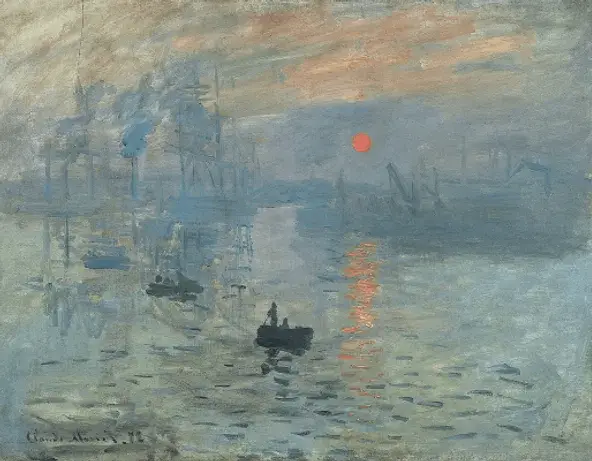Title of Artwork: Impression, Sunrise

Artwork by Claude Monet
Year Created 1872
Impression, Sunrise by Claude Monet Canvas Print
Summary of Impression, Sunrise
Impression, Sunrise is arguably Claude Monet’s most well-known work, but it is also the piece that most people associate with the Impressionist movement ecause it has the same name! It was completed in 1873 and acts as a placeholder in the history of art, paving the way for thousands of subsequent works.
When Impression, Sunrise was originally shown in 1874, art critic Louis Leroy mocked Monet’s work by using the term “Impressionistic,” which comes from the title of this picture. This title was rapidly adopted by the Impressionist painters, and the show, which included additional works by Impressionist artists, became known as the “Impressionist Exhibition” from then on. This painting was stolen from the Musee Marmottan Monet in Paris in 1985, but it was discovered in good condition in 1990 and returned to the museum in 1991.
All About Impression, Sunrise
Impression Sunrise by Claude Monet is often credited as the work that launched the Impressionist movement, despite the fact that at the time it was painted, Monet was already one of a number of painters working in the new style. However, in a satirical review of the First Impressionist Exhibition in 1874, critic Louis Leroy made derogatory remarks about the work and its title, which gave rise to the term “Impressionism” The term was coined as a joke in Leroy’s review, but it was quickly adopted by the new school of painters in a spirit of pride and defiance.
Claude Monet was born in Paris to a family of middle-class merchants. His parents were hardworking and financially secure, but not wealthy or aristocratic, and Monet struggled to make a living as a painter throughout his early career. Monet’s family moved from Paris to Le Havre when he was a child, and while he returned to Paris in the early 1960s to study art, it was during a visit to his family in Le Havre in 1872 that he created this and other similar works.
Impression, Sunrise is notable for the colour palette’s consistency between sea, land, and sky. The gentle blues, oranges, and greens of sunrise bathe them all. The painting’s subject is the enveloping warmth and colour of sunlight itself, or rather the “impression” it makes on the senses at a given moment in time, rather than the city it depicts or the anonymous boatmen setting out across the water. The new style was defined by the painting of light and the time-specific effects of light.
In 1872, Monet created a number of sketches of the same scene, including Impression, Sunrise. The painter was known for his serial approach to the subject matter. In other occasions, Monet would produce vast cycles of work portraying the same subject at several times of day or seasons, highlighting the way light and atmosphere changed with the passage of time. The 25 paintings that make up the series Les Meules à Giverny (1890-91), often known as “The Haystacks” are the most famous examples of this technique.
The two tiny rowboats in the front and the crimson Sun are the focus features of Impression, Morning, which shows the harbour of Le Havre at sunrise. More fishing boats are seen in the centre area, while clipper ships with lofty masts are depicted in the backdrop on the painting’s left side. More foggy objects behind them are “are not trees but smokestacks of pack boats and steamships, while on the right in the distance are other masts and chimneys silhouetted against the sky.” Monet removed existing homes on the left side of the jetty to expose these industrial elements, leaving the background unobscured.
Following France’s loss in the Franco-Prussian War of 1870–71, the flourishing port of Le Havre became a symbol of the country’s rebirth. The contrast between the steamboats and cranes in the background and the fishermen in the foreground, according to art historian Paul Tucker, represents these political implications: “This painting of a highly commercial site may have been seen by Monet as a response to postwar calls for patriotic action and art that could lead. While the painting is a poem of light and mood, it is also a homage to the strength and beauty of a rejuvenated France.”
The depiction of Le Havre, Monet’s hometown and a centre of industry and trade, honours the country’s “renewed strength and beauty of the country… Monet’s ultimate utopian statement.” Monet’s image of the sunrise over Le Havre reflects France’s rebirth.
Impression, Sunrise’s foggy setting deviated from traditional landscape painting and romanticised beauty. According to Paul Smith, Monet intended to communicate “other beliefs about artistic quality which might be tied to the ideologies being consolidated by the emergent bourgeoisie from which he came.” using this technique. The emerging Impressionist movement is demonstrated by loose brush strokes designed to suggest rather than mimetically reproduce the landscape. This style exhibited inventive individualism in the aftermath of France’s emerging industrialisation.
Monet created his painting on canvas with a foundation layer of grey in various tones. Despite the lack of fine details, the layered approach creates a rich and real-world that resembles Le Havre, but not exactly. Art critics discuss boundaries and colour in Impression, Sunrise, claiming that the sky and water are barely distinguishable, object boundaries are blurry, and the paint “becomes the place” and effect, with the paint’s colours melding together in “its glooming, opalescent oneness, its foggy blankness, it’s featureless, expectant emptiness that resembles the sky.”
Impression, Sunrise by Claude Monet Framed Print
Information Citations
En.wikipedia.org, https://en.wikipedia.org/.
























